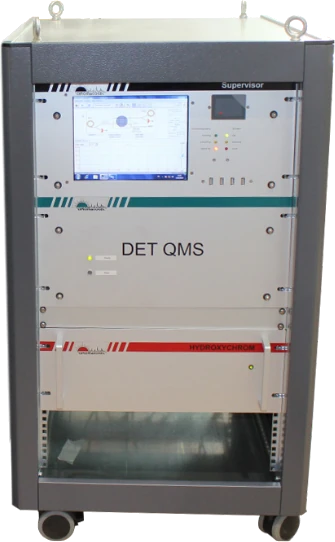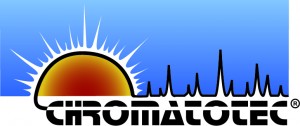Technical Specifications

- Analyzer:
- 1-300 amu
- 6×100 mm rod-system with pre filter
- Faraday cup (high concentrations – % and for service)
- SEM dynode (low concentrations – down to ppb)
- Detection limits:
- Direct MS < 50 ppb for Benzene
- auto GCMS: after airmoVOC C10 C40 expert <10 ppt for Benzene and after chroma FID <10 ppb for Benzene
- Mass Axis Stability:
- >0.2 UMA/year
- Detection range:
- With airmoVOC from 0.01 ppb until 10000 ppb
- With chroma FID from 10 ppb until 100 000 ppb
- 7 decades dynamic range 0,1 ppm – 100 % with direct MS
- Relative Standard Deviation:
- RSD < 3 % on concentration over 48H
- RSD < 0.3% on retention time over 48H
- Results:
- Full result storage (data and chromatogram)
- Embedded computer Windows® based with LCD display
- 128 GB of Hardware storage on SSD memory
- 4 USB Connecting Port
- Two RS-232 ports
- Display: 10’’ TFT Color LCD
- MODBUS RTU / JBUS communication protocol
- Data Storage (timestamp)
- Cycle time:
- 4 ms – 60 s (in standard)
- From 2 min for fast GCMS to 60min for trap GCMS of more than 100 compounds
- Gas supply:
- H2 (FID and carrier gas): 30 ml/min (supply 2 bar ; 1/16’’double ferrule)
- Air (FID) : 180 ml/min (supply 3 bar ; 1/8’’double ferrule
- Sample supply (sample pump) 1/4’’double ferrule
- Pneumatic valve 90ml/commutation
Our unique stand-alone autoGCMS solution for ambient air VOC monitoring
Our unique stand-alone autoGCMS solution enables monitoring of ambient air VOCs for a wide range of applications, including ozone precursors, atmospheric research, toxic compounds, fenceline monitoring, hygiene, and industrial air monitoring.
CHROMATOTEC’s autoGCMS solution is a highly modular and flexible system designed to meet customer needs across diverse use cases such as:
- Ambient air monitoring for ozone precursors with a focus on speciated VOCs from PAMS, Annex VII of European Directive 2024/2881, and several hundred additional VOCs.
- Atmospheric research, enabling real-time monitoring of up to 300 different VOCs, including alkanes, alkenes, aromatics, biogenic VOCs, oxygenated VOCs, mercaptans, formaldehyde, and many more, with full compound speciation.
- Toxic air monitoring in accordance with international standards such as TO-14, TO-15, and other GCMS protocols.
- Workplace hygiene monitoring, targeting specific VOCs with cycle times as low as 2 minutes, from ppt to ppm levels, using the autoGCMS system.
- Fenceline monitoring of a wide range of VOCs, with multi-point sampling to reduce cost per measurement point depending on regulations.
- Industrial air applications, such as filter efficiency studies and industrial research by filtration manufacturers, benefiting from the system’s flexibility.
The custom-made analyzer is built around the most suitable CHROMATOTEC autoGCMS instrument, featuring embedded gas generators for cylinder-free operation.
It includes certified embedded permeation tubes at low ppb or ppt levels for automatic validation of system performance directly in the field. All VOC compounds can be produced using certified permeation tubes, enabling validation even for the most challenging compounds, anywhere.
Unmatched analytical capabilities with the autoGCMS system
The analytical gold-standard method of the autoGCMS system delivers:
- High chromatographic accuracy, even at ppt or low ppb levels
- Fast analysis cycles using mass spectrometry
- Ultra-high sensitivity and selectivity, even for complex samples, with cycle times of 10 to 15 minutes
- Automatic data processing
- Field identification of unknown compounds using the onboard NIST library
The only fully automated rack-mount autoGCMS designed for field use, requiring only electricity
CHROMATOTEC autoGCMS – Features and Benefits
Key Features:
- Modular design with optional modules to analyze over 300 compounds, including formaldehyde, mercaptans, OVOCs, NH₃, etc.
- Reference technology for VOC monitoring with advanced compound speciation.
- Automatic alarms based on concentration thresholds or instrument status.
- Extremely stable performance over time: <3% RSD at 10 ppb concentration maintained for over 4 months without calibration or tuning.
- Fast autoGCMS cycle (a few minutes) for 10–30 VOCs, or longer cycles for >100 VOCs on the same system.
- LOQ (Limit of Quantification) automatically computed by the software: <10 pptv.
- Calibration on a single compound using FID Relative Response Factors and the Effective Carbon Number concept (autoGCMS includes both FID and MS detectors).
- Wide dynamic range from ppt to ppm in a single analysis, ideal for industrial incidents or sudden concentration spikes.
- Controlled multiplexing and automated data validation/calibration.
Main Benefits:
- Approved and validated by major international institutions: US EPA, MCERTs, TUV, CNRS, ACTRIS Supersite, and more.
- Comes with a recommended list of standard compounds, customizable on-site.
- Full remote control and data reporting capabilities.
- No memory effects, even when switching between ppm and ppt levels — ideal for multiplexed sampling.
- Onboard zero-air generator and certified multi-compound permeation tubes ensure continuous self-validation — no need for calibration cylinders or transport for calibration.
- Compatible with industrial protocols (Modbus TCP).
- Designed to evolve with customer and market needs.
- Stand-alone operation requiring only power.
- Yearly preventive maintenance limited to mass tuning verification.
Application Areas
Ambient air monitoring – Ozone precursors
Typical compounds:
- PAMS list (56–61 compounds, depending on version)
- 47 VOCs from Annex VII of European Directive 2024/2881
- Biogenic VOCs
→ Total: more than 300 VOCs analyzable
Atmospheric research
Custom-built systems to monitor a wide spectrum of VOCs, upgradeable over time.
Typical compounds:
- Alkanes, Alkenes, Aromatics
- Oxygenated VOCs, Biogenic VOCs
- Aldehydes: Formaldehyde, Acetaldehyde
- PAHs, Chlorinated/Brominated VOCs
- S-VOCs, linear alkanes up to C20 (C40 with add-on module)
Outdoor air & Fenceline monitoring
Automated system with alarm levels.
Typical compounds:
- Aldehydes, Ketones, Glycol ethers
- Pyrolysis products (e.g., biomass burning)
- VOCs & Condensables (sticky compounds)
- Formaldehyde, H₂S, Mercaptans, Sulfides
- Nitrogenous compounds: Acetonitrile, NH₃, Amines
Standards, Approvals & Certifications





